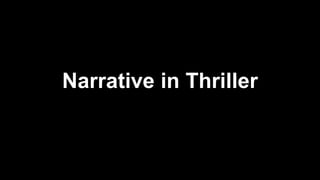Thriller narratives
- 2. Gone Girl
- 3. Setup Nick Dunne going about his day. Typically used to introduce characters and their lives
- 4. Inciting Incident His wife is missing Close to the beginning of a movie where a character's normal life is changed
- 5. Act 1 Climax Some characters and the audience suspect that Nick had something to do with his wifeâs disappearance. He now has to prove his innocence. Usually used to send the plot into a new direction
- 6. Midpoint The audience learns that Amy isnât missing and how she faked her death is revealed. Nick hires a lawyer and tries to prove he had nothing to do with it. Major shift in dynamic of the story, the character has a major success, devastating failure or a powerful revelation
- 7. Act 2 Part 2 Amy stays at her exâs house. Nick goes on TV to defend himself. Things get serious. The protagonist faces conflict internally and externally
- 8. Climax Amy kills her ex and frames him for rape. She comes home Big finale, the protagonist and antagonist face each other. Tension and conflict are at their highest.
- 9. Resolution Amy and Nick settle back into married life and things go back to normal. Loose ends are tied up. The audience have a sigh of relief
- 10. Memento â Memento â neo-noir-psychological thriller film â both linear and non-linear â two different sequences â flashbacks
- 11. Black and white scenes â chronological â linear narrative â flashbacks on his job before he lost his memory. Gives insight on
- 12. Color scenes â non-linear â Shown in reverse order â voice over, his thoughts as he is thinking them â makes the viewer empathise
- 13. Enigma Here the enigma is introduced by the prop of the polaroid picture. This gives the audience some questions about the subject and direction of the film without revealing enough to detract from the mystery of the plot
- 14. Enigma â The audience doesnât know how long ago the flashbacks were just like the protagonist â The audience thinks they know who killed his wife, at the end a twist is revealed â the audience has questions
- 15. Salinui chueok (Memories of Murder) â Murder mystery
- 16. â Enigma, figuring out who killed the girl â Suspense is created when detectives find clues suggesting the identity of someone who did it. â We are left with an open ended ending
- 17. the aim of every enigma is to retain the interest of the audience and to provide something which can engage them in the plot
- 19. Conventional storytelling has a set structure of beginning, middle, and end, however, they do not always happen in this order. Flashbacks are used throughout the film. There are two main interviews going on and they happen at different times but are interspersed
- 20. By using these flashbacks to flesh out the story, the film not only finds a unique way of grasping the audiences attention, but also in how conventional storytelling is able to be altered in film for the sake of itâs story structure
- 21. Enigma At the end of the film a twist is revealed which is a big pay off for the viewer that answers questions that the viewer had.




















